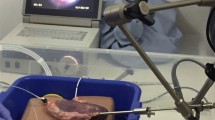Summary
In 1976 a modified suction system for neurosurgery and precision surgery was presented. It was developed to meet the need for efficient and atraumatic liquid suction. The system consists of suction tube ends provided with three vertical slits in the suction edge (W-tubes), a Pressure Control Unit (PCU) and an independent suction pump with an air capacity of 25–30 litres per min. This system has subsequently been modified for microsurgery. The PCU normally controls the negative pressure to 20 kPa (corresponding to 200 cm of water) for atraumatic suction of liquid, which is needed during most of the operating time. For suction of various tissues or cleaning the system, the surgeon can set the pressure limit to 50 or 90 kPa by means of a foot-operated IR-transmitter in a pedal with a kick-down function. The PCU and the W-tubes, which neutralize the pressure load on tissue and the sudden interruption of liquid flow that are inevitable with conventional suction tips, form a system with a high liquid suction capacity in spite of the atraumatic suction pressure. This is possible because the slits maintain a large active suction area. Crushed or soft tissues and coagulated blood are aspirated as and when required, if necessary by elevation of the negative pressure limit. The W-tubes are not provided with an air inlet hole on the tube because that method of pressure control proved unpredictable and variable and reduced the suction capacity by interfering with the flow. The system permits continuous efficient and safe suction of liquid in contact with nervous tissue and hence provides a good range of vision in the operation field even in cases of extensive haemorrhage (> 500 ml of blood per min). The system forms a good complement to ultrasonic aspiration, which is mainly intended for atraumatic tissue elimination.
Similar content being viewed by others
References
Bondurant, C. P.: Alteration of suction tip pressure. J. Neurosurg. 46 (1977) 559
Vällfors, B.: A new surgical sucker end. Acta Chir. Scand. 137 (1971) 700–701
Vällfors, B.: Neurosurgical suction systems. An experimental study. Thesis. University of Göteborg, Göteborg, Sweden, 1976
Vällfors, B., H.-A. Hansson: Modified suction system for neurosurgery. Surg. Neurol. 13 (1979) 397–399
Vällfors, B., Hansson, H.-A. Johansson, et al.: Studies on optimal conditions in surgical suction systems. Acta Chir. Scand. Suppl. 474, 1976
Vällfors, B. Hansson, H.-A. Larsson, et al.: Suction in neurosurgery. Acta Neurochir. 55 (1980) 35–42 Suction tube ends protected by Swedish pat. 354776.
Author information
Authors and Affiliations
Rights and permissions
About this article
Cite this article
Vällfors, B. Efficient atraumatic liquid suction by means of slit suction tubes combined with a pressure control unit. Neurosurg. Rev. 7, 179–182 (1984). https://doi.org/10.1007/BF01780702
Issue Date:
DOI: https://doi.org/10.1007/BF01780702




